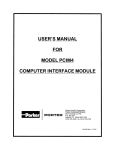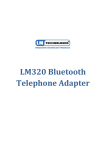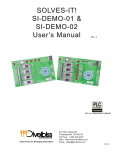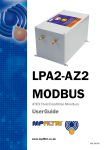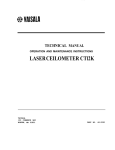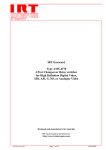Download models cm2 and cm4 interface modules user`s manual
Transcript
MODELS CM2 AND CM4 INTERFACE MODULES USER’S MANUAL MODEL CM2 MODEL CM4 Parker Hannifin Corporation PORTER Porter Instrument Division 245 Township Line Rd. P.O. Box 907 Hatfield, PA 19440-0907 USA (215) 723-4000 / fax (215) 723-2199 FM-264 Rev. H 8/07 TABLE OF CONTENTS Page PRODUCT DESCRIPTION........................................................................................................... 2 Specifications ................................................................................................................... 2 THEORY OF OPERATION ........................................................................................................... 3 General Information ......................................................................................................... 3 Power Supply Module ...................................................................................................... 3 Signal Conditioning Module ............................................................................................. 3 Interconnect Module ........................................................................................................ 5 Front Panel Module.......................................................................................................... 5 OPERATION OF EQUIPMENT .................................................................................................... 7 General Information ......................................................................................................... 7 Normal Mode Operation................................................................................................... 7 APT Mode Operation ....................................................................................................... 7 Verification of Calibration ................................................................................................. 8 Digital Panel Meter Adjustment ....................................................................................... 8 Equipment Calibration...................................................................................................... 8 POLICIES AND CERTIFICATE OF WARRANTY ........................................................................ 10 FIGURES AND DRAWINGS Switching Code for IC Multiplexers U1 and U2 (Table 1) ................................................ 4 Front Panel (Model CM4 Shown) (Figure 1).................................................................... 6 Back Panel (Model CM4 Shown) (Figure 2) .................................................................... 6 APT Combinations (Table 2)............................................................................................ 8 Rear Panel Connectors Pin Function (Table 3) ............................................................... 9 Power Supply Module Schematic (Drawing KB20000) ................................................... 11 Power Supply P.C. Board Assembly (Drawing KB20001)............................................... 12 Signal Conditioning Module Schematic (Drawing KB19705)........................................... 13 Interconnect Module Schematic (Drawing KB19704)...................................................... 14 Porter Interface Module (CM2 and CM4) Interconnection Diagram (Drawing FM-261) ........................................................ 15 1 PRODUCT DESCRIPTION Porter’s Interface Modules Models CM2 and CM4 are designed for use with all Porter Instrument Series 100 Mass Flowmeters (MFM’s) and Series 200 Mass Flow Controllers (MFC’s). Model CM2 employs two (2) channels, accepting flow signal inputs and providing setpoint control for each channel. Model CM4 includes four (4) flow signal input channels and likewise has a setpoint control for each channel. Process flow rates for all channels are displayed on a large, bright, red digital panel meter as a percentage of full scale (F.S.). The range of this meter is from 000.0 to 102.4 percent. Setpoints for any channel may also be displayed on the digital panel meter in the same percentage of full scale flow units. Setpoints are adjustable to any value in the previously stated range using the ten (10)-turn adjustment controls. Specifications Function: Processes 0 to 5 Vdc flow signal inputs from Series 100 MFM’s and Series 200 MFC’s to provide readout in percentage of full scale (F.S.) flow. For Series 200 MFC’s, provides 0 to 5 Vdc setpoint control outputs. Inputs: Model CM2: Two (2) channels. Model CM4: Four (4) channels. Inputs (flow signal line plus common) enter instrument via 15-pin D-type connectors CH1, CH2, CH3 (Model CM4 only) and CH4 (Model CM4 only) on rear panel. Setpoints: One (1) setpoint potentiometer per channel, adjustable from 0 to 102.4% F.S. with ten (10)-turn control. Control action occurs when the process flow value in a given channel matches its respective setpoint. Both models also feature Automatic Proportional Tracking (APT) Mode operation. APT operation permits setting the flow rate control in one or more channels to be a fixed ratio of the flow rate control in a reference channel, regardless of the process flow rate in that reference channel. Display: Red, 3½ digit (0.56 in. high) digital panel meter with 0.1% resolution. Auxiliary (AUX) Outputs: Available for each channel at rear panel via 25-pin D-type AUX connector for remote output signal use. Models CM2 and CM4 are completely selfcontained with internal modular construction. Although they are multi-featured instruments, their operation is extremely simple. Automatic Proportional Tracking (APT) Control: Control switches located on rear panel permit fixed internal reference for all setpoint channels or selected flow signal references for all setpoint channels except Channel 1. Power Requirements: 117 Vac (± 10%), 50 to 60 Hz, 50 watts max. Line fuse (rear panel) is rated at 0.5A Slo-Blo. Housing Style: Table-top mounting. Dimensions: 8-1/2"W x 4-7/8"H x 9 3/4"D. Weight: Model CM2: 6 lbs. Model CM4: 6 lbs. 2 THEORY OF OPERATION Likewise, capacitors C4 and C5 (in parallel) plus C7 are the counterparts of C3 and C6 respectively. GENERAL INFORMATION Flow signals from individual MFM’s and/or MFC’s are processed by Model CM2/CM4 for digital display of flow rates in percentage of full scale and, if user-selected, APT operation of MFC’s. Model CM2/CM4 also provides a setpoint source required for MFC’s. These functions are accomplished by four (4) modular circuit assemblies. These modules are designated as follows: The regulator (U4), used to develop the precise reference voltage (5.120 Vdc), is a LM317LZ. Resistor R1 sets a value of current through R2 by virtue of the fixed voltage across it, as established by the output terminals of U4. The total voltage across R1 and R2 is approximately 5.12 volts. Adjustment potentiometer R4 and resistor R3 set the junction of R1 and R2 such that the final output voltage across the filter capacitor C8 is exactly 5.120 Vdc. 1. Power Supply Module 2. Signal Conditioning Module 3. Interconnect Module (includes interconnect PC board, rear panel and rear panel components). 4. Front Panel Module (includes digital panel meter, selector switches and setpoint controls). SIGNAL CONDITIONING MODULE (Refer to schematic # KB19705) The purpose of the Signal Conditioning Module is to multiplex (switch) up to four (4) input flow signals into a single (1) output meter signal. Setpoint signal levels are also available at the input of the multiplexer and may be selected for display on the digital panel meter. POWER SUPPLY MODULE (Refer to schematic # KB20000) The Power Supply Module is comprised of a PC board and 'L'- shaped chassis which mounts to the PC board and off-board power transformer. The power supply provides three regulated supplies: +5 Vdc, +15 Vdc and -15 Vdc, plus a precise +5.120 Vdc reference supply. They operate all functional circuitry within the Model CM2/CM4. The +5 Vdc supply is specifically intended to power the digital panel meter. Multiplexers U1 and U2 (type CD4051) electronically switch eight (8) analog signal inputs to a single (1) output. A three (3)-bit binary code applied to pins 9 through 11 determines which inputs are switched to the output. Flow signals are applied to the first four (4) inputs of U1. The common return lines for these flow signals are applied to four (4) inputs on U2. The four (4) setpoint signal levels are applied to the second (2nd) set of inputs on U1. They are also fed from this same location out to their respective MFC via connector 2J1, the interconnect PC board and channel input connectors 1J1 and 1J2 (Model CM2) and 1J1 through 1J4 (Model CM4). The 117 Vac primary winding of power transformer X1 is fed from the power cord, ½ amp line fuse, ON/OFF switch and a pair of quick disconnect-type connectors J3-1 to J3-2. The +5 Vdc three (3)- terminal regulator, U1 (LM340-5), receives its applied voltage from a fullwave rectifier/filter CR2, CR3 and C1. Capacitor C2 serves as a transient suppressor. The binary switching code for the IC multiplexers U1 and U2 is defined in Table 1. Keep in mind that switching code inputs C, B and A (pins 9, 10 and 11) relate to binary weighting columns 22, 21 and 20 respectively. Also remember the 'C' code input on IC U2 (pin 9) is connected directly to ground and is the only input which is not switched. Regulators U2 and U3 (LM340 and LM320) form the basis for the dual +15 and -15 Vdc power supplies. The positively oriented rectifier diodes (part of CR5) apply their full-wave voltage to filter capacitor C3. Capacitor C6 acts to suppress transients. Note that the negatively oriented rectifier diodes (part of CR5) are the counterparts of those previously mentioned. Examples of flow and setpoint selection are given following Table 1. 3 THEORY OF OPERATION TABLE 1: SWITCHING CODE FOR IC MULTIPLEXERS U1 AND U2 Setpoint and Flow Signal Common Flow Signal Channel No. C Binary Code B A 1 0 0 0 13 2 0 0 1 14 3 0 1 0 15 4 0 1 1 12 1 1 0 0 1 2 1 0 1 5 3 1 1 0 2 4 1 1 1 4 Assume a binary code of 110 is applied to the control input of U1. Since pin 9 is grounded on U2, its C, B and A code inputs would read 010. This means channel 3's flow signal and common return line are switched through to operational amplifier buffers U3A and U3B (LM324) respectively. Also note the control inputs for U1 and U2, which are not held low (zero volts) by the front panel CHANNEL SELECTOR switch connected via 2J6, are pulled high to Vcc (+12 Vdc) by resistors RN3-1, RN3-2 and RN3-3. IC Input Pin Selected code now becomes 000, causing the first setpoint to be selected. In other words, changing the binary 22 weighting column (Code C) from a '1' to a '0' switches the digital panel meter's display from flow signals to setpoint signals. The 5 Vdc (maximum flow signal) at the output of unity gain buffer U3A is divided down to a 1 Vdc (maximum) signal by resistors R3 and R4. The common return line reference level for the flow signal is fed from unity gain buffer U3B to a resistor network consisting of R1, R2 and zero control R6. This control (R6) adjusts the common return line level to exactly zero (0) volts with no flow signal applied. Signals present between the two output lines are applied to the digital panel meter via connector 2J4. Depressing the FLOW/SETPOINT switch on the front panel activates (via pin 9 on U1) the second (2nd) group of signal levels applied to U1's inputs, namely the setpoint signals. The CHANNEL SELECTOR switch programs the channel desired to be displayed on the digital panel meter. For example, with the FLOW/SETPOINT switch not depressed and the CHANNEL SELECTOR switch set to CH1, IC U1's C, B and A code input will be 100, meaning the first flow signal and its common return are being selected. By depressing the FLOW/SETPOINT switch the 4 THEORY OF OPERATION Operational amplifier U3C serves as an inverting amplifier with a gain of X1 to convert its +5.12 Vdc input signal to a -5.12 Vdc output level. Both polarities of 5.12 Vdc are required for zero control R6. Operational amplifier U3D is connected as a unity gain buffer to apply a +12 Vdc level, divided down from +15 Vdc by resistors R5 and RN3-8, to CMOS multiplexers U1 and U2 as +Vcc. Connector 2J2 applies to the various power supply voltages to the signal conditioning PC board, which are carried through to connector 2J3, for application to field-located MFM’s and/or MFC’s. connect to the previously mentioned 26-pin connector 1J6 via PC foils on the Interconnect PC board. The +15 Vdc and -15 Vdc supplies, along with the +5.120 Vdc reference voltage, enter the Interconnect PC board via connector 1J7 and exit via connectors 1J1, 1J2, 1J3 (Model CM4 only) and 1J4 (Model CM4 only). Connector 1J5 is designated AUX and is mounted on the rear panel. It supplies 0 to 5 Vdc flow signals to external meters, recorders, etc., when required. The last items to be noted here are the ON/OFF power switch and power line FUSE, also located on the rear panel. INTERCONNECT MODULE (Refer to schematic # KB19704) Note: The theory of any special control applications should be discussed with Porter Instrument’s technical personnel. All signals to and from the 'outside world' are made via the Interconnect Module. Therefore, consider this module as an input/output PC board with attached connectors and switches, mounted to the back panel. FRONT PANEL MODULE (Refer to schematic # KB19705) The digital panel meter, CHANNEL SELECTOR switch, FLOW/SETPOINT switch and SETPOINT controls (CH1 & CH2 – Model CM2; CH1 through CH4 – Model CM4), along with their respective cable/connector assemblies, make up the Front Panel Module. Two (2) (Model CM2) or four (4) (Model CM4) sets of input/output signals are available on the 26-pin connector 1J6. Each set relates to a given channel. They include: 1) a 0 to 5 Vdc flow signal input, 2) its common return, 3) a setpoint signal output and 4) an auxiliary control input. Also note one (1) slide switch (Model CM2), SW1, or four (4) slide switches (Model CM4), SW1 through SW4, present in the schematic and located on the back panel. Further note that these switches allow the setpoint lines to be connected to the internal reference voltage (5.120 Vdc) or to the output signal of channel 1 (Models CM2 and CM4) or channel 3 (Model CM4 only). Channel 1 is always referenced to the internal 5.120 Vdc reference voltage. The possible combinations for referencing are as follows: CH2 to CH1, CH3 to CH1, CH4 to CH1 or CH4 to CH3 (the possible combinations involving channels 3 and 4 [CH3 and CH4] are available only with Model CM4). This arrangement relates to the APT mode control feature discussed in various sections of this user’s manual. The actual range of the digital panel meter is 0 to 1.999 Vdc. Shifting the decimal point two (2) places to the right enables the meter to read 100.0% for a 1.000 Vdc flow signal input. The CHANNEL SELECTOR switch is a four (4)position, two (2)-pole rotary switch which establishes a two (2)-column binary code (22 and 20) to program the appropriate coding inputs on IC U1 and U2 of the Signal Conditioning Module. The FLOW/SETPOINT push-button switch selects flow signals (binary 1 in the 22 column) or setpoint levels (binary 0 in the 22 column). Setpoint potentiometers are ten (10)-turn controls which provide a continuous 0 to 5.120 Vdc level to the inputs of IC U1 noted above, as well as the field-located MFC’s. Keep in mind the 5.120 Vdc divided down 5:1 equals 1.024 Vdc, which in turn, equals a displayed value of 102.4% on the digital panel meter. Refer to the theory discussion on the Signal Conditioning Module for further details. The two (2) (Model CM2), 1J1 and 1J2, or four (4) (Model CM4), 1J1 through 1J4, individual channel input/output connectors located on the rear panel are designated CH1, CH2, CH3 (Model CM4 only) and CH4 (Model CM4 only). The individual channel input/output connectors 5 OPERATION OF EQUIPMENT FIGURE 1: FRONT PANEL (MODEL CM4 SHOWN) Digital Panel Meter SETPOINT Controls CHANNEL SELECTOR Switch ON/OFF Switch FLOW/SETPOINT Switch Fuse AUX Connector 1J5 1J4 I/O Connectors 1J3 1J2 1J1 SW4 SW3 SW2 SW1 NORM/APT Slide Switches Power Cord FIGURE 2: BACK PANEL (MODEL CM4 SHOWN) 6 OPERATION OF EQUIPMENT GENERAL INFORMATION APT MODE OPERATION As previously mentioned, Models CM2 and CM4 are used to provide a digital display of flow signals for Porter Instrument Series 100 MFM’s, or to provide a digital display for both flow signals and setpoint controls for Porter Instrument Series 200 MFC’s. Review the explanation offered for APT (Automatic Proportional Tracking) Mode operation given in the third paragraph under the heading titled "General Information" on this page. Position the selected NORM/APT slide switch(es) so that the channel(s) which is (are) to 'follow' or 'track' a given reference channel is (are) set to the right side, to the dotted line(s). Control action of the Models CM2 and CM4 may take place in the Normal Mode or APT Mode. Normal mode occurs when the setpoint control in each channel is connected to a precise and fixed internal reference voltage. The SETPOINT control is then adjusted to a control point given as a percentage of full scale flow. Table 2, found on the following page, indicates all APT combinations available. The Back Panel pictorial representation, located on the bottom of the previous page, illustrates the NORM/APT slide switches. APT Mode occurs when one or more setpoint controls are connected, not to the internal reference voltage, but to a selected channel's flow signal output. This scheme permits automatic proportional blending of two (2) or more gases. In other words, if Channel 2's setpoint control is connected to Channel 1's flow signal output, then Channel 2's flow rate control becomes a fixed fractional ratio of Channel 1's flow rate, even if Channel 1's flow rate falls below its control limits. The important thing to remember when establishing APT Mode operation is to follow the dotted lines associated with the slide switches. These lines indicate which channel is 'tracking' a particular reference channel. Also note depressing the FLOW/SETPOINT push-button switch when the CHANNEL SELECTOR switch is set to display, the channel using APT Mode operation will now make the meter display the adjusted ratio of the reference channel's flow signal. That ratio is determined by the setting of the particular SETPOINT control switched into the APT Mode, and will be read on the meter as a percentage of a percentage. NORMAL MODE OPERATION Confirm the NORM/APT slide switches on the rear panel are set to the left side, to the solid line and reference arrows marked REF. FOR INDEP. CONT. Set the CHANNEL SELECTOR switch to the desired channel and read the digital panel meter for the process flow signal's percentage of full scale flow. Press the FLOW/SETPOINT switch located on the front panel and adjust the appropriate SETPOINT control until the desired setpoint value is displayed on the digital panel meter. 7 OPERATION OF EQUIPMENT TABLE 2: APT COMBINATIONS CM2 CM4 Channel 1 I I Channel 1 2 3 4 I I I I I APT I I I APT APT I I APT APT APT I I APT I I I APT APT I I I APT I APT I APT I I I APT I APT I APT meter's red plastic filter/bezel. This can be done by placing a small, thin screwdriver blade under the recess at the bottom center of the filter/bezel. 2. With CHANNEL SELECTOR switch set to CH1 and Channel 1's SETPOINT control adjusted fully clockwise, depress the FLOW/SETPOINT push-button switch and maintain depressed. 3. Adjust the meter’s calibration potentiometer, R14 (located to the right of the display digits), until the meter indicates 102.4%. 4. Replace filter/bezel. 2 I APT NOTES: 1. I = Independent Control 2. APT = Automatic Proportional Tracking Example: A Model CM2 is being operated in the APT Mode, with Channel 2 'tracking' Channel 1. Channel 1's SETPOINT Control is adjusted to 50.0 percent of full scale flow. Channel 2's SETPOINT Control is adjusted to 80.0 percent of Channel 1's controlled flow. This means Channel 2's flow rate should be controlled at 40 percent of full scale flow. In addition, for Model CM4, Channel 4 can track Channel 3 in the same manner. The major advantage of APT Mode operation in this case is even if the flow rate in Channel 1 falls below its control limits, Channel 2's flow rate will remain a fixed ratio or proportion (80 percent) of Channel 1's flow rate. EQUIPMENT CALIBRATION This procedure should not be necessary, but may be conducted if there is reason to believe the equipment is, or may be, out of calibration. Calibration of Model CM2/CM4 simply means adjusting the +5.120 Vdc reference supply for +5.120 Vdc (±.002 Vdc). Proceed as follows: 1. Remove upper cover of the enclosure (housing). 2. Connect A/C power cord and turn unit on. 3. Locate the Channel 1’s SETPOINT control on the back of the front panel module. Using a 4½- digit, .05% accurate digital voltmeter, connect the positive (red) test probe to terminal lug # 3 of the setpoint control and the negative (black) test probe to terminal lug # 1 of the setpoint control. 4. Locate potentiometer R4 on the ‘L’-shaped power supply module (refer to Power Supply P.C. Board Assembly drawing # KB20001). Adjust potentiometer R4 until the voltmeter reads 5.120 Vdc (±.002 Vdc). 5. Perform 'Verification of Calibration' and 'Digital Panel Meter Adjustment'. Calibration is now complete. VERIFICATION OF CALIBRATION Both Models CM2 and CM4 are shipped precisely calibrated and ready to use. If needed, the calibration can be confirmed using the digital panel meter. Proceed as follows: 1. Set the CHANNEL SELECTOR switch to CH1; 2. Rotate Channel 1's SETPOINT control fully clockwise; 3. Press the FLOW/SETPOINT push-button switch. The digital panel meter should display 102.4 percent. DIGITAL PANEL METER ADJUSTMENT If the digital panel meter reading obtained in the procedure above is not correct, you may assume the meter has 'drifted' slightly, since the reference supply, the basis for the equipment's calibration, is considered extremely accurate and stable (unless it is malfunctioning). Therefore, proceed as follows: 1. 'Pop' off the 8 OPERATION OF EQUIPMENT TABLE 3: REAR PANEL CONNECTORS PIN FUNCTION Connector # CH1 and CH2 (Model CM2) Connector # CH1, CH2, CH3 and CH4 (Model CM4) PIN NO. 1 2 3 4 5 6 7 8 9 10-15 FUNCTION Cable Shield 0-5 Vdc Setpoint Flow Signal Common Circuit Common Flow Signal Output Circuit Common +15 Vdc Power No Connection -15 Vdc Power No Connection Auxiliary (AUX) Connector PIN NO. 1 2 3 4 5 6 7 8 9-25 FUNCTION Flow Signal Output Flow Signal Common Flow Signal Output Flow Signal Common Flow Signal Output Flow Signal Common Flow Signal Output Flow Signal Common No Connection 9 CHANNEL 1 1 2 2 3 3 4 4 CERTIFICATE OF WARRANTY POLICIES PRICES CANCELLATIONS All prices are F.O.B. Hatfield, PA, and subject to change without notice. All merchandise will be invoiced at prices in effect at time of shipment. Prices do not include insurance, freight, taxes or special handling. These charges, if applicable, will be shown separately on invoice. Minimum order $30.00. No cancellations will be accepted on non-standard or special merchandise, except by payment of full purchase price. If buyer requests cancellation of any order or part thereof, and is agreed to by Porter Instrument Division in writing, buyer will be subject to cancellation charges to cover the cost of material and/or fabrication incurred by Porter Instrument Division to date of cancellation. PAYMENT TERMS Net 30 days after invoice date. All invoices past due are subject to a finance charge of 1½% per month (18% annual rate). CHANGES OF ORDER A minimum of 90 days notice is required on all changes to orders and will be subject to rescheduling as a new order at Porter Instrument Division’s discretion. SHIPMENTS Shipment of merchandise shall at times be subject to credit approval and will be contingent upon fires, accidents, emergencies, acts of God or any other causes which are beyond Porter Instrument Division’s control. RETURNS No returns will be accepted unless authorized in writing by Porter Instrument Division and accompanied by a properly completed Returned Goods Authorization. All returns are subject to restocking and possible rework charges to be determined by Porter Instrument Division. Specifications and dimensions subject to change. CERTIFICATE OF WARRANTY THIS WARRANTY IS GIVEN IN PLACE OF ALL OTHER WARRANTIES, EXPRESS OR IMPLIED, OF MERCHANTABILITY, FITNESS FOR A PARTICULAR PURPOSE, OR OTHERWISE. NO PROMISE OR STATEMENT MADE BY ANY REPRESENTATIVE OR AUTHORIZED DEALER OF PARKER HANNIFIN CORP. SHALL CONSTITUTE A WARRANTY BY PARKER HANNIFIN CORP. Parker Hannifin Corporation, Porter Instrument Division, warrants this equipment to be free from defects in workmanship and materials, when used in accordance with applicable specifications and with appropriate maintenance, for one (1) year from date of delivery to the customer, unless otherwise specified in writing. Equipment which malfunctions may be returned, shipment prepaid, to Parker Hannifin Corporation, Porter Instrument Division, for test and evaluation. Equipment determined to be defective and in warranty will be repaired or replaced at no charge to the customer. Equipment out of warranty will be evaluated, and if the equipment does not meet original specifications and calibration, the customer will be notified of the costs before proceeding with repair or replacement. Repaired equipment will be warranted ninety (90) days from date of delivery to the customer or for the balance of the original warranty, whichever is longer. Failures due to shipping damage, accident, misuse, improper mechanical or electrical installation or operation, or internal clogging or corrosion due to use of contaminated fluids or inadequate system purging are excluded from warranty coverage. Parker Hannifin Corporation’s obligation for breach of this warranty, or for negligence or otherwise, shall be strictly and exclusively limited to the repair or replacement of the equipment. This warranty shall be void as to any equipment on which the serial number, if applicable, has been altered, defaced, or removed. Parker Hannifin Corporation shall under no circumstances be liable for incidental or consequential damages. No other promise or statement about the equipment by any representative or authorized dealer of Parker Hannifin Corporation shall constitute a warranty by Parker Hannifin Corporation or give rise to any liability or obligation of Parker Hannifin Corporation. 10 11 12 13 14 15
















